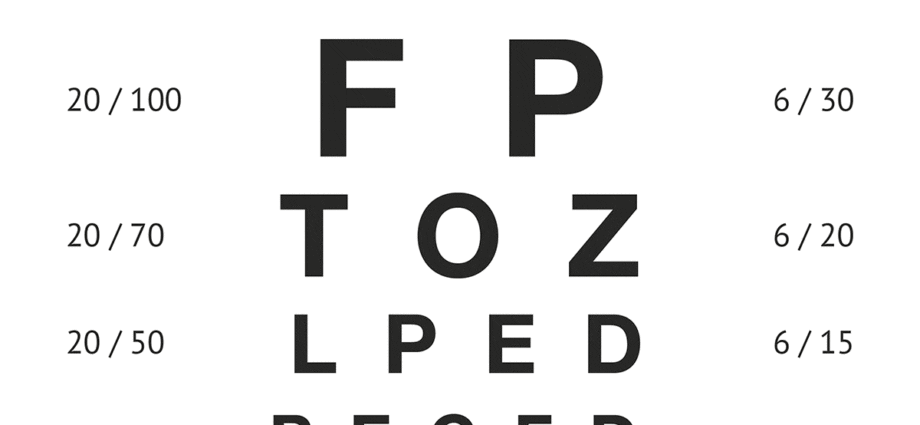Visual acuity: how to measure it?
Blurred vision, poor vision, or visual disturbance, it may be time to have a visual acuity test. But what does this test consist of? Where can it be done?
What is visual acuity?
Visual acuity is visual performance. It measures the ability of the eye to distinguish details, with or without glasses. For Sandrine Garnier, orthoptist, “it is measured in tenths and on a scale of 1 out of 20 for low visual acuity to 16 out of 10. In far vision, 16/10 corresponds to very good visual acuity, while 1/10 reveals a deficiency ”.
The case of the emmotrope
When the best visual acuity is obtained without correction, the patient is said to be emmetropic. The light rays converge correctly towards the back of the retina, which allows the brain to perceive a sharp image.
The case of ametrope
When the patient has to wear a correction to see clearly, he is said to be ametropic. There are different types of visual acuity problems:
- myopia: the patient has difficulty seeing from a distance,
- hyperopia: near vision is poorer than far vision,
- astigmatism: vision is blurred regardless of the distance,
- presbyopia: linked to age (from 45 years old), this physiological pathology alters near vision.
Visual acuity changes over time: it starts at around 1/30 at one month and reaches 10/10 around 5 years old. It then declines around 45/50 years in near vision and gradually decreases the rest of life.
How is the visual acuity test performed?
The patient sits on a chair at a distance of five meters from a screen on which will be projected “optotypes”, these characters of different sizes and more and more decreasing. The ophthalmologist or orthoptist then measures near and far visual acuity, with or without glasses and for each eye. At each step, one eye is covered while the other deciphers the optotypes projected on the screen. He starts with the larger characters and then tries to read the smaller ones. At each line, the doctor notes the capacities of the eye. The same examination is done with the other eye, then in binocular, that is to say with both eyes.
If the patient can read all the characters correctly without correction, he or she does not have a visual acuity defect. On the other hand, if he has difficulty reading certain lines, the specialist will place corrective lenses until he can read the smallest characters clearly.
At the end of the examination, the specialist will define your visual acuity. If it requires correction, he will prescribe glasses for you to have made by an optician.
Tools for measuring visual acuity
The Parinaud scale
There are two kinds of optotypes for measuring visual acuity. The Parinaud scale, for near vision, is made up of texts grouped into paragraphs. The characters in each paragraph are different and appear in decreasing size. The texts are organized according to a size scale: 14 for the largest characters and 1.5 for the smallest. The pad is placed about 40 centimeters from the patient, an arm’s length.
ETDRS scale
“To measure far vision, the ETDRS scale must be used, which is very precise,” adds the orthoptist. It is expressed in the number of letters read. The ladder should be placed five meters from the patient.
The other tests
For children or people who do not recognize letters, it is possible to use drawing scales, Snellen’s E’s, numbers or even broken rings (Landolt’s optotype) instead of letters.
What to do in case of reduced visual acuity?
Visual acuity loss can occur when vision becomes blurry or discomfort appears. In this case, do not hesitate to make an appointment with an ophthalmologist or an orthoptist who will give you tests. Attention, it is necessary to have a visual acuity of 5/10 minimum for the driving license. Do not hesitate to take exams before taking the driving license.
How often should you check your visual acuity?
Children under the age of 3 should be monitored at least once a year. This is because the faster the vision problems are corrected, the better your child’s eyesight will be as an adult. Visual examinations can begin at birth if an abnormality is detected. New devices exist to diagnose visual abnormalities in children, such as the pediatric autorefractometer or examinations with cycloplegic eye drops, which prevent accommodation.
“For children with glasses, it is advisable to consult every six months or a year. For adults without pathology, the check-up is done every two years and for those with pathologies (diabetes, AMD, glaucoma, etc.) once or twice a year. The replacement of glasses can be ensured by the ophthalmologist, the orthoptist or the optician ”concludes Sandrine Garnier.










